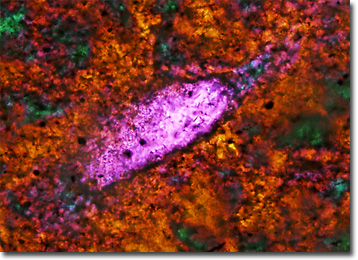Polarized Light Microscopy Digital Image Gallery
Obsidian Snowflake
Obsidian is a type of natural glass formed from lava cooled at a rapid rate. The material was utilized by the ancient Greeks and Aztecs for mirrors and by the Native Americans for sharp tools and weapons, but is today most heavily used for jewelry, figurines, and other ornamental items.

Though often brown to black in color, a wide variety of obsidians exist, many of which are utilized as semiprecious gemstones. When hematite is present, the glass has a red tint, and small bubbles of air can cause either a golden sheen or multihued sheen, resulting in what is commonly called sheen obsidian and rainbow obsidian. A type of obsidian known as mountain mahogany or mahogany obsidian, on the other hand, is a deep red, often with streaks or swirls of black and gray. Another familiar form of the glass is frequently referred to as Apache tears, dark gray or black pebble-like nodules usually found in association with perlite.
Obsidian snowflake is a black variety of obsidian that features inclusions of a white mineral, which appear similar to snowflakes when polished. This mineral has been identified as cristobalite, a stable form of silica, in many samples. In some areas, the radiating crystals are believed to be more reminiscent of flowers than snowflakes, resulting in the materialís alternate moniker, flowering obsidian. The most notable occurrence of the unusual black and white glass can be found near Milford, Utah.
